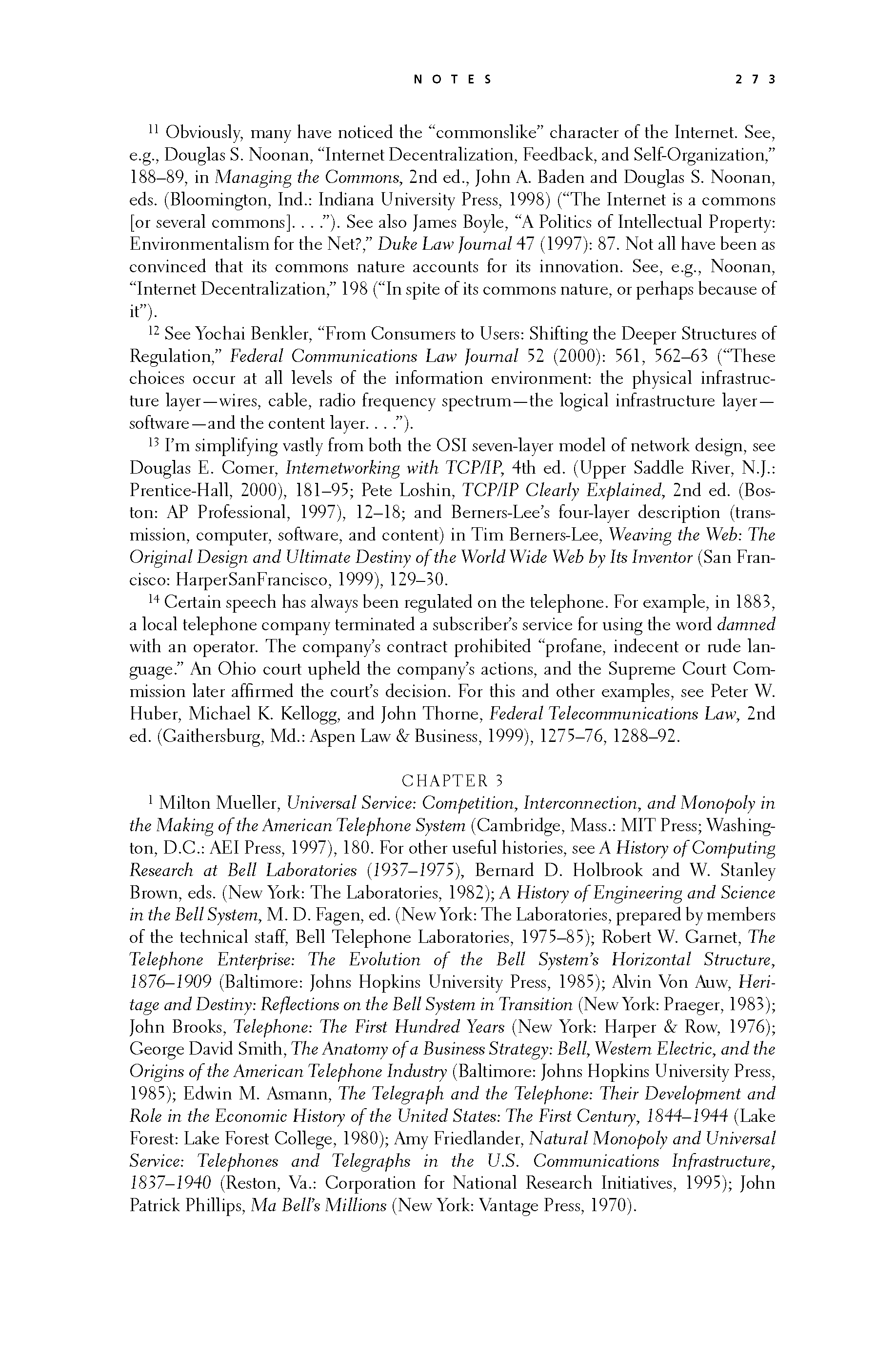 p272 _
-chap- _
toc-1 _
p273w _
toc-2 _
+chap+ _
p274
p272 _
-chap- _
toc-1 _
p273w _
toc-2 _
+chap+ _
p274
[2-11] Obviously, many have noticed the "commonslike" character of the Internet. See,
e.g., Douglas S. Noonan, "Internet Decentralization, Feedback, and Self-Organization,"
188-189, in _Managing_the_Commons,_ 2nd ed., John A. Baden and Douglas S. Noonan,
eds. (Bloomington, Ind.: Indiana University Press, 1998) ("The Internet is a commons
[or several commons]..."). See also James Boyle, "A Politics of Intellectual Property:
Environmentalism for the Net?," _Duke_Law_Journal_ 47 (1997): 87. Not all have been as
convinced that its commons nature accounts for its innovation. See, e.g., Noonan,
"Internet Decentralization," 198 ("In spite of its commons nature, or perhaps because of
it").
[2-12] See Yochai Benkler, "From Consumers to Users: Shifting the Deeper Structures of
Regulation," _Federal_Communications_Law_Journal_ 52 (2000): 561, 562-563 ("These
choices occur at all levels of the information environment: the physical infrastruc-
ture layer -- wires, cable, radio frequency spectrum -- the logical infrastructure layer --
software -- and the content layer...").
[2-13] I'm simplifying vastly from both the OSI seven-layer model of network design, see
Douglas E. Comer, _Internetworking_with_TCP/IP,_ 4th ed. (Upper Saddle River, N.J.:
Prentice-Hall, 2000), 181-195; Pete Loshin, _TCP/IP_Clearly_Explained,_ 2nd ed. (Bos-
ton: AP Professional, 1997), 12-18; and Berners-Lee's four-layer description (trans-
mission, computer, software, and content) in Tim Berners-Lee, _Weaving_the_Web:_The_
_Original_Design_and_Ultimate_Destiny_of_the_World_Wide_Web_by_Its_Inventor_ (San Fran-
cisco: HarperSanFrancisco, 1999), 129-130.
[2-14] Certain speech has always been regulated on the telephone. For example, in 1883,
a local telephone company terminated a subscriber's service for using the word _damned_
with an operator. The company's contract prohibited "profane, indecent or rude lan-
guage." An Ohio court upheld the company's actions, and the Supreme Court Com-
mission later affirmed the court's decision. For this and other examples, see Peter W.
Huber, Michael K. Kellogg, and John Thorne, _Federal_Telecommunications_Law,_ 2nd
ed. (Gaithersburg, Md.: Aspen Law & Business, 1999), 1275-1276, 1288-1292.
Chapter 3
[3-1] Milton Mueller, _Universal_Service:_Competition,_Interconnection,_and_Monopoly_in_
_the_Making_of_the_American_Telephone_System_ (Cambridge, Mass.: MIT Press; Washing-
ton, D.C.: AEI Press, 1997), 180. For other useful histories, see _A_History_of_Computing_
_Research_at_Bell_Laboratories_(_1937-1975_)_,_ Bernard D. Holbrook and W. Stanley
Brown, eds. (New York: The Laboratories, 1982); _A_History_of_Engineering_and_Science_
_in_the_Bell_System,_ M. D. Fagen, ed. (New York: The Laboratories, prepared by members
of the technical staff, Bell Telephone Laboratories, 1975-1985); Robert W. Garnet, _The_
_Telephone_Enterprise:_The_Evolution_of_the_Bell_System's_Horizontal_Structure,_
_1876-1909_ (Baltimore: Johns Hopkins University Press, 1985); Alvin Von Auw, _Heri-_
_tage_and_Destiny:_Reflections_on_the_Bell_System_in_Transition_ (New York: Praeger, 1983);
John Brooks, _Telephone:_The_First_Hundred_Years_ (New York: Harper & Row, 1976);
George David Smith, _The_Anatomy_of_a_Business_Strategy:_Bell,_Western_Electric,_and_the_
_Origins_of_the_American_Telephone_Industry_ (Baltimore: Johns Hopkins University Press,
1985); Edwin M. Asmann, _The_Telegraph_and_the_Telephone:_Their_Development_and_
_Role_in_the_Economic_History_of_the_United_States:_The_First_Century,_1844-1944_ (Lake
Forest: Lake Forest College, 1980); Amy Friedlander, _Natural_Monopoly_and_Universal_
_Service:_Telephones_and_Telegraphs_in_the_U.S._Communications_Infrastructure,_
_1837-1940_ (Reston, Va.: Corporation for National Research Initiatives, 1995); John
Patrick Phillips, _Ma_Bell's_Millions_ (New York: Vantage Press, 1970).
[[273]]
p272 _
-chap- _
toc-1 _
p273w _
toc-2 _
+chap+ _
p274